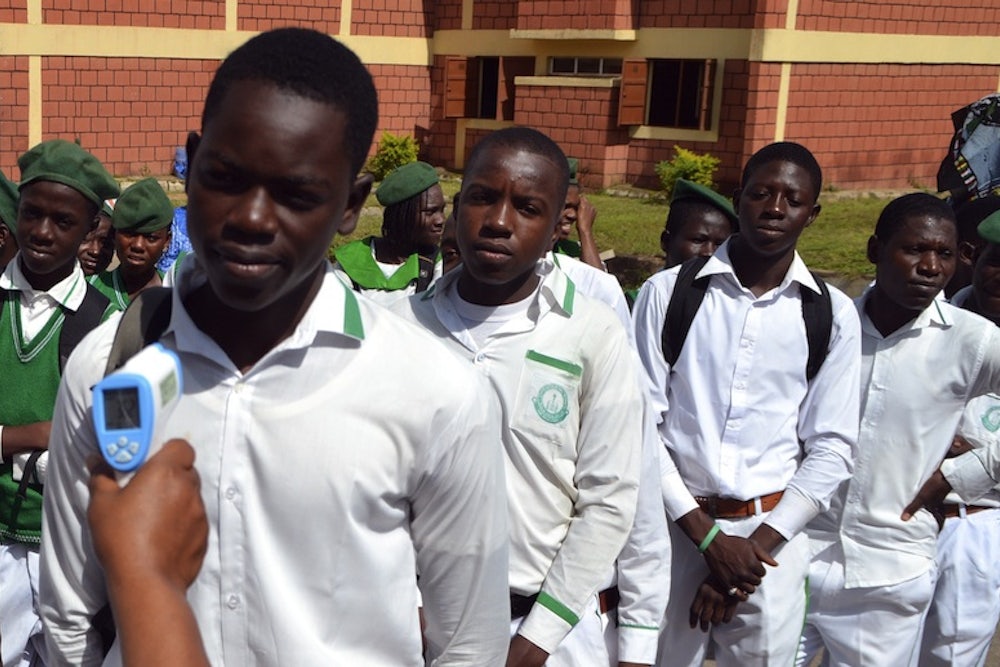The best news about Ebola probably isn’t the recovery of two American nurses who cared for Thomas Duncan or the apparent lack of new cases among other health care workers who administered to him. It’s the announcement that Nigeria, Africa’s most populous country, has been free of new cases for six weeks. It’s a story of remarkable, largely unexpected success. And it appears to include a genuine hero—the kind that comes along too rarely in the news business.
The hero was a physician named Stella Ameyo Adadevoh and she is already becoming a legend, thanks in part to stories that the BBC, the Guardian, and the Telegraph pieced together from interviews, official statements, and accounts in the Nigerian press. The tale that they tell starts in late July, at the First Consultant Hospital in Lagos, when an ambulance brought a patient named Patrick Sawyer directly from the airport. He’d collapsed on the tarmac after getting sick and vomiting on a flight from Liberia. He told health care workers he was suffering from malaria.

Plenty of caregivers would have found the story credible. Although Ebola was spreading through West Africa by that point, it hadn’t come to Nigeria and many doctors would have missed the telltale signs. Adadevoh, on duty that day, didn't. She recognized the significance of the symptoms, given Sawyer’s travel history, and ordered him into isolation. Then she notified public health officials that she had a possible case of Ebola on her hands.
Sawyer did not take the news well, according to the British news accounts. As local authorities would later learn, he had cared for his sister, who’d died from Ebola, and he knew he had the disease. That’s why he had come to Nigeria—in search of a cure from a “miracle pastor” at a Pentecostal church. “He was more intent on leaving the hospital than anything else,” a national health department official told the BBC.
At one point, Sawyer ripped out his intravenous lines as he tried to get away, forcing Adadevoh and her staff to restrain him physically in order to keep him in place. They succeeded, but Adadevoh would later wage a different kind of battle—against Liberian officials, who said that Sawyer, a government worker, had to leave so that he could attend a conference in a coastal city. Adadevoh said she wouldn’t allow it and hospital officials stood by her. Sawyer went nowhere and, a few days later, he succumbed to the illness.
My attempts to re-report this story from here in the U.S. haven’t worked, so I’m relying on the European journalists for the details. Like all such stories, it might involve a little hagiography or myth-making. I can’t say for sure. But this much I know: The decision to isolate Sawyer likely prevented him from spreading the disease to many more people in Lagos, a city of 18 million people with large slums. An outbreak in that environment is the scenario public health officials fear most. Tracing known contacts and isolating them—the time-tested strategy that Nigerian and U.S. officials later used to contain the disease—would have been much more difficult, maybe even impossible, in such a dense and disorganized place.
But Sawyer managed to infect a few people and, tragically, Adadevoh was among them. Officials think it’s likely she contracted the virus through exposure to Sawyer’s blood, which was spraying out of his arms when he yanked those IV lines. She died on August 11. A campaign to memorialize her, with some kind of posthumous government medal, is already underway.
If you implement or study public policy, or if, like me, you write about it, you tend focus on systems and programs—what’s working and what isn’t, what should be done differently and what should be done again, and so on. That’s a perfectly reasonable way to think about Nigeria’s efforts at containing Ebola.
In the end, health care workers ended up conducting about 18,500 personal interviews, then identifying and isolating about 900 possible direct or indirect contacts of Sawyer. Just 20 of them ended up getting sick and more than half of them survived. Officials at the World Health Organization have cited Nigera’s response as a model for other nations. That’s quite an accomplishment for a country not known for effective public administration, particularly when it comes to medical care. The last time WHO ranked health systems across the world, in 2000, it put Nigeria’s at 187—out of 190.
But in this case, history didn’t simply change because government agencies successfully implemented a well-designed plan. It also changed because one person thought quickly and acted, under duress, and paid the ultimate price. Her name was Stella Adadevoh.
